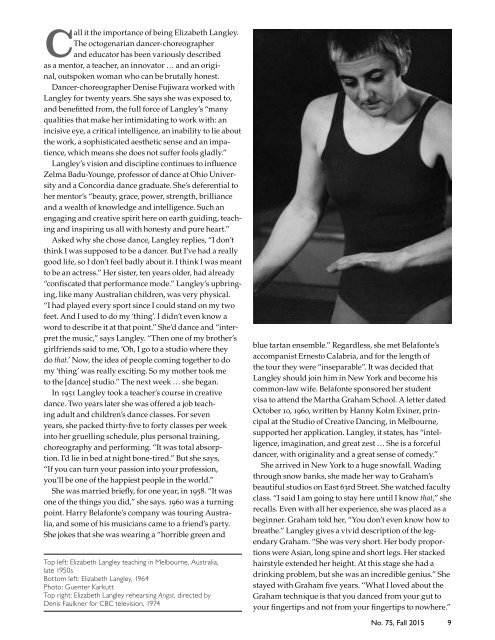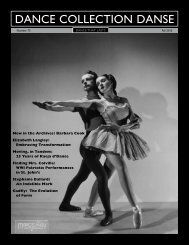DANCE COLLECTION DANSE
3E8Oe3fJp
3E8Oe3fJp
You also want an ePaper? Increase the reach of your titles
YUMPU automatically turns print PDFs into web optimized ePapers that Google loves.
Call it the importance of being Elizabeth Langley.<br />
The octogenarian dancer-choreographer<br />
and educator has been variously described<br />
as a mentor, a teacher, an innovator … and an original,<br />
outspoken woman who can be brutally honest.<br />
Dancer-choreographer Denise Fujiwara worked with<br />
Langley for twenty years. She says she was exposed to,<br />
and benefitted from, the full force of Langley’s “many<br />
qualities that make her intimidating to work with: an<br />
incisive eye, a critical intelligence, an inability to lie about<br />
the work, a sophisticated aesthetic sense and an impatience,<br />
which means she does not suffer fools gladly.”<br />
Langley’s vision and discipline continues to influence<br />
Zelma Badu-Younge, professor of dance at Ohio University<br />
and a Concordia dance graduate. She’s deferential to<br />
her mentor’s “beauty, grace, power, strength, brilliance<br />
and a wealth of knowledge and intelligence. Such an<br />
engaging and creative spirit here on earth guiding, teaching<br />
and inspiring us all with honesty and pure heart.”<br />
Asked why she chose dance, Langley replies, “I don’t<br />
think I was supposed to be a dancer. But I’ve had a really<br />
good life, so I don’t feel badly about it. I think I was meant<br />
to be an actress.” Her sister, ten years older, had already<br />
“confiscated that performance mode.” Langley’s upbringing,<br />
like many Australian children, was very physical.<br />
“I had played every sport since I could stand on my two<br />
feet. And I used to do my ‘thing’. I didn’t even know a<br />
word to describe it at that point.” She’d dance and “interpret<br />
the music,” says Langley. “Then one of my brother’s<br />
girlfriends said to me, ‘Oh, I go to a studio where they<br />
do that.’ Now, the idea of people coming together to do<br />
my ‘thing’ was really exciting. So my mother took me<br />
to the [dance] studio.” The next week … she began.<br />
In 1951 Langley took a teacher’s course in creative<br />
dance. Two years later she was offered a job teaching<br />
adult and children’s dance classes. For seven<br />
years, she packed thirty-five to forty classes per week<br />
into her gruelling schedule, plus personal training,<br />
choreography and performing. “It was total absorption.<br />
I’d lie in bed at night bone-tired.” But she says,<br />
“If you can turn your passion into your profession,<br />
you’ll be one of the happiest people in the world.”<br />
She was married briefly, for one year, in 1958. “It was<br />
one of the things you did,” she says. 1960 was a turning<br />
point. Harry Belafonte’s company was touring Australia,<br />
and some of his musicians came to a friend’s party.<br />
She jokes that she was wearing a “horrible green and<br />
Top left: Elizabeth Langley teaching in Melbourne, Australia,<br />
late 1950s<br />
Bottom left: Elizabeth Langley, 1964<br />
Photo: Guenter Karkutt<br />
Top right: Elizabeth Langley rehearsing Angst, directed by<br />
Denis Faulkner for CBC television, 1974<br />
blue tartan ensemble.” Regardless, she met Belafonte’s<br />
accompanist Ernesto Calabria, and for the length of<br />
the tour they were “inseparable”. It was decided that<br />
Langley should join him in New York and become his<br />
common-law wife. Belafonte sponsored her student<br />
visa to attend the Martha Graham School. A letter dated<br />
October 10, 1960, written by Hanny Kolm Exiner, principal<br />
at the Studio of Creative Dancing, in Melbourne,<br />
supported her application. Langley, it states, has “intelligence,<br />
imagination, and great zest … She is a forceful<br />
dancer, with originality and a great sense of comedy.”<br />
She arrived in New York to a huge snowfall. Wading<br />
through snow banks, she made her way to Graham’s<br />
beautiful studios on East 63rd Street. She watched faculty<br />
class. “I said I am going to stay here until I know that,” she<br />
recalls. Even with all her experience, she was placed as a<br />
beginner. Graham told her, “You don’t even know how to<br />
breathe.” Langley gives a vivid description of the legendary<br />
Graham. “She was very short. Her body proportions<br />
were Asian, long spine and short legs. Her stacked<br />
hairstyle extended her height. At this stage she had a<br />
drinking problem, but she was an incredible genius.” She<br />
stayed with Graham five years. “What I loved about the<br />
Graham technique is that you danced from your gut to<br />
your fingertips and not from your fingertips to nowhere.”<br />
No. 75, Fall 2015 9




